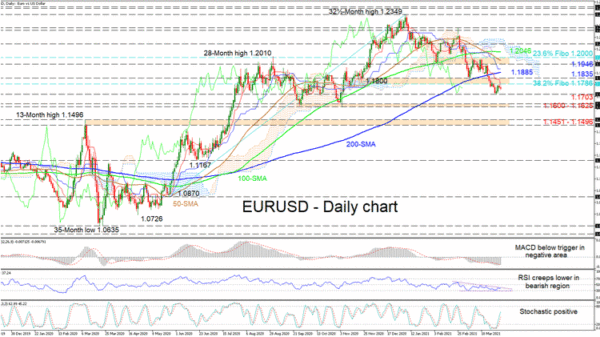EURUSD’s correction below the 200-day simple moving average (SMA) is transmitting a growing bearish tone. The falling 50-day SMA appears to be heading for a bearish crossover of the 200-day SMA as well, which would further power the negative picture. The flattening blue Kijun-sen line is reflecting the minor bounce in the pair however, the Ichimoku lines are backing the price’s descent.
That said, the short-term oscillators are conveying conflicting signals in directional momentum. The MACD, some distance under the zero mark, is below its red trigger line but is looking to peek above it, while the sliding RSI, is aiming for the 30 level. The stochastic oscillator is sustaining its positive charge and is endorsing price improvements.
If sellers remain in control, preliminary downside constraints may develop at the nearby 1.1703 barrier. Steering beneath this, a more profound push from sellers could be required to conquer the crucial support base of 1.1600-1.1625. Should this key foundation fail to negate the decline from snowballing, the bears may then target another significant support zone, residing between 1.1496 and 1.1451.
Otherwise, if buying interest intensifies, resistance could originate from the 1.1786 immediate level until the 1.1835 inside trough, the former being the 38.2% Fibonacci retracement of the up leg from 1.0870 to 1.2349. Overcoming this boundary, the 200-day SMA lingering above at 1.1885 may impede buyers from propelling higher to challenge the heavy resistance section of 1.1946-1.2000, which also encompasses the 50-day SMA. Successfully stepping over the latter, which is the 23.6% Fibo, the Ichimoku cloud and the 100-day SMA – currently at 1.2046 – could then attempt to calm buyer’s confidence.
Summarizing, the current bearish outlook will strengthen further should EURUSD remain below the 1.1786-1.1835 barrier and the 200-day SMA.


 Signal2forex.com - Best Forex robots and signals
Signal2forex.com - Best Forex robots and signals




